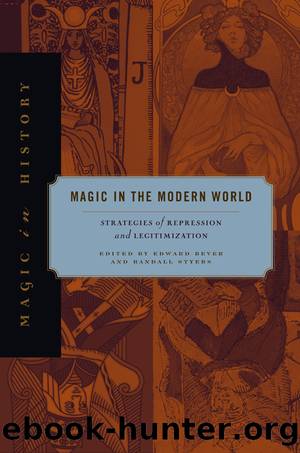Magic in the Modern World by Edward Bever & Randall Styers

Author:Edward Bever & Randall Styers
Language: eng
Format: epub
Publisher: Penn State University Press
The Purist Turn
Although purism as a strategy was present already in Crowleyâs day, it was only in the late 1970s that it became a dominant trend. Indeed, there was something of a âpurist turnâ in occultist discourse on Enochiana around this time, sparked by a number of core publications that made the historical origin of the systemâand its discrepancy from the Golden Dawn synthesisâimpossible to ignore. In 1974, Stephen Skinner published a facsimile edition of Casaubonâs True and Faithful Relation.65 Then, in 1976 and 1978, two dictionaries of the Enochian language appeared: Leo Vinciâs Gmicalzoma and Donald C. Laycockâs Complete Enochian Dictionary. The first recapitulated the etymological fantasies of Brodie-Innes and Regardie. Laycock, by contrast, a trained linguist, supplied his dictionary with a solid introduction analyzing various linguistic features of the language, even debunking the claim that Enochian could be anything like a genuine ânatural language.â66 With these tools available, more attention was directed toward the original sources in the 1980s.
The clearest example of a consistent purist is Robert Turner, who in the late 1970s became the head of the Order of the Cubic Stone, based in the English Midlands. Throughout the 1970s, this order had been known for its very practical approach to magic with a Golden Dawn orientation.67 Under Turnerâs leadership, two things occurred. Enochian magic became the main focus of the group, and this magic was explored in a fairly academic way. As one ex-student put it, âthe sole focus hinged upon what could be reconstructed from the Dee material.â68
Based on his own diligent research on original manuscripts at the British Library and the Bodleian in Oxford, Turner published two books that have become classics of the purist turn of Enochiana, The Heptarchia Mystica of John Dee (1983) and Elizabethan Magic (1989). The Heptarchia Mystica was the first publication of the heptarchic system ever to appear in print. In its introduction, Turner expresses his bafflement over the neglect of the heptarchic system; it was really âthe only true example of a complete magical system to be found in the Dee papers,â yet modern occultists had neglected it completely.69 Instead, they had constructed grand syntheses out of various incomplete systems.
Despite the emphasis on scholarly method, Turnerâs motivations were clearly practical. At the end of the introduction to Heptarchia Mystica, Turner declared, âA Midlands based occult group have recently reconstructed the Holy Table, wax discs and other necessary equipment and shortly hope to perform the Heptarchical rite, publishing their findings in due course. Whether or not the spirits will welcome this invasion of their four hundred year repose remains uncertain.â70 If Turner is the clearest representative of the purist current, he is by no means the only one.71 Another important book from this era is Geoffrey Jamesâs Enochian Evocation of Dr. John Dee (1984), which attempted to âpresent the essential core of Deeâs evocation system arranged in a fashion similar to other renaissance evocation texts.â72 This was the first book to publish material from the entire set of Deeâs
Download
This site does not store any files on its server. We only index and link to content provided by other sites. Please contact the content providers to delete copyright contents if any and email us, we'll remove relevant links or contents immediately.
The Compleat Magical Path Magic Lessons by John Cross(375)
The Return of the Dragon : The Shocking Way Drugs and Religion Shape People and Societies by Lewis Ungit(353)
THEM: They Come at Night by Tom Lyons(344)
Dogme et Rituel de la Haute Magie Part I by Eliphas Levi(330)
The Mind at Large: Clairvoyance, Psychics, Police and Life after Death: A Polish Perspective by Weaver Zofia & Janoszka Krzysztof(330)
Strange Tricks by Syd Moore(327)
Psychic Secrets by Jade-Sky(313)
The Iron Republic by Richard Jameson Morgan(312)
Shaman: The Mysterious Life and Impeccable Death of Carlos Castaneda by Mike Sager(310)
Kabbalah and Sex Magic by Marla Segol(308)
101 Ways to Jump-Start Your Intuition by John Holland(306)
Cult Cinema: A Personal Exploration of Sects, Brainwashing and Bad Religion in Film and Television by Ingham Howard(305)
Kickstart My Witch (Witch's Guide to Haunted Properties: Los Angeles: Mystery Book 1) by Lotta Smith(287)
Haunted Ships: True Paranormal Ghost Ship Stories by Press Chronicle(285)
The Satanism Scare by Joel Best(280)
Evil Unleashed: True Tales of Spells Gone to Hell and Other Occult Disasters by John Harker(276)
The Airmen Who Would Not Die by Fuller John G(271)
The Ghost Hunter's MOST HAUNTED Box Set (3 in 1) by Terrance Zepke(269)
The A-Z of Curious London by Gilly Pickup(263)
